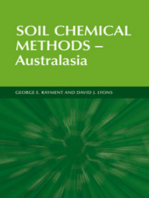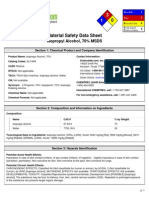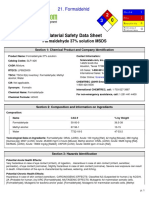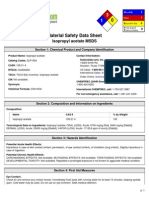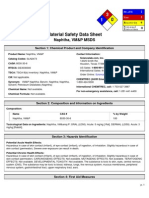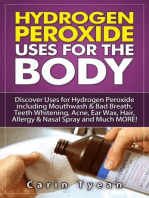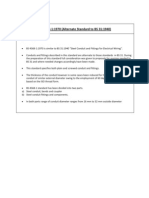Phenolphthalein Solution, 1% MSDS: Section 1: Chemical Product and Company Identification
Phenolphthalein Solution, 1% MSDS: Section 1: Chemical Product and Company Identification
Uploaded by
Holly RochaCopyright:
Available Formats
Phenolphthalein Solution, 1% MSDS: Section 1: Chemical Product and Company Identification
Phenolphthalein Solution, 1% MSDS: Section 1: Chemical Product and Company Identification
Uploaded by
Holly RochaOriginal Description:
Original Title
Copyright
Available Formats
Share this document
Did you find this document useful?
Is this content inappropriate?
Copyright:
Available Formats
Phenolphthalein Solution, 1% MSDS: Section 1: Chemical Product and Company Identification
Phenolphthalein Solution, 1% MSDS: Section 1: Chemical Product and Company Identification
Uploaded by
Holly RochaCopyright:
Available Formats
3 1
Material Safety Data Sheet
Phenolphthalein Solution, 1% MSDS
Section 1: Chemical Product and Company Identification
Product Name: Phenolphthalein Solution, 1% Catalog Codes: SLP4165 CAS#: Mixture. RTECS: Not applicable. TSCA: TSCA 8(b) inventory: Water; Isopropyl alcohol; Phenolphthalein, powder CI#: Not applicable. Synonym: Phenolphthalein Solution, 1% in 95% Isopropyl alcohol Chemical Name: Not applicable. Chemical Formula: Not applicable. Contact Information: Sciencelab.com, Inc. 14025 Smith Rd. Houston, Texas 77396 US Sales: 1-800-901-7247 International Sales: 1-281-441-4400 Order Online: ScienceLab.com
He a lt h
2 3 0 J
Fire Re a c t iv it y P e rs o n a l P ro t e c t io n
CHEMTREC (24HR Emergency Telephone), call: 1-800-424-9300 International CHEMTREC, call: 1-703-527-3887 For non-emergency assistance, call: 1-281-441-4400
Section 2: Composition and Information on Ingredients
Composition: Name Water Isopropyl alcohol Phenolphthalein, powder CAS # 7732-18-5 67-63-0 77-09-8 % by Weight 4 95 1
Toxicological Data on Ingredients: Isopropyl alcohol: ORAL (LD50): Acute: 5045 mg/kg [Rat]. 3600 mg/kg [Mouse]. 6410 mg/kg [Rabbit]. DERMAL (LD50): Acute: 12800 mg/kg [Rabbit]. Phenolphthalein, powder LD50: Not available. LC50: Not available.
Section 3: Hazards Identification
Potential Acute Health Effects: Hazardous in case of eye contact (irritant), of ingestion, . Slightly hazardous in case of skin contact (irritant, sensitizer, permeator). Non-corrosive for skin. Non-corrosive to the eyes. Non-corrosive for lungs. Potential Chronic Health Effects: CARCINOGENIC EFFECTS: Classified A4 (Not classifiable for human or animal.) by ACGIH, 3 (Not classifiable for human.) by IARC [Isopropyl alcohol]. Classified 1 (Clear evidence.) by NTP [Phenolphthalein, powder]. Classified 2B (Possible for human.) by IARC [Phenolphthalein, powder]. MUTAGENIC EFFECTS: Mutagenic for mammalian somatic cells. p. 1
[Phenolphthalein, powder]. TERATOGENIC EFFECTS: Not available. DEVELOPMENTAL TOXICITY: Classified Reproductive system/toxin/female, Development toxin [POSSIBLE] [Isopropyl alcohol]. The substance may be toxic to kidneys, liver, skin, central nervous system (CNS). Repeated or prolonged exposure to the substance can produce target organs damage.
Section 4: First Aid Measures
Eye Contact: Check for and remove any contact lenses. Immediately flush eyes with running water for at least 15 minutes, keeping eyelids open. Cold water may be used. Get medical attention. Skin Contact: Wash with soap and water. Cover the irritated skin with an emollient. Get medical attention if irritation develops. Cold water may be used. Serious Skin Contact: Not available. Inhalation: If inhaled, remove to fresh air. If not breathing, give artificial respiration. If breathing is difficult, give oxygen. Get medical attention if symptoms appear. Serious Inhalation: Evacuate the victim to a safe area as soon as possible. Loosen tight clothing such as a collar, tie, belt or waistband. Seek medical attention. Ingestion: Do NOT induce vomiting unless directed to do so by medical personnel. Never give anything by mouth to an unconscious person. Loosen tight clothing such as a collar, tie, belt or waistband. Get medical attention if symptoms appear. Serious Ingestion: Not available.
Section 5: Fire and Explosion Data
Flammability of the Product: Flammable. Auto-Ignition Temperature: The lowest known value is 399C (750.2F) (Isopropyl alcohol). Flash Points: The lowest known value is CLOSED CUP: 11.7C (53.1F). (TAG). OPEN CUP: 23C (73.4F). (Cleveland). (Isopropyl alcohol) Flammable Limits: The greatest known range is LOWER: 2% UPPER: 12.7% (Isopropyl alcohol) Products of Combustion: These products are carbon oxides (CO, CO2). Fire Hazards in Presence of Various Substances: Highly flammable in presence of open flames and sparks, of heat. Flammable in presence of oxidizing materials. Nonflammable in presence of shocks, of reducing materials, of combustible materials, of organic materials, of metals, of acids, of alkalis, of moisture. Explosion Hazards in Presence of Various Substances: Slightly explosive in presence of oxidizing materials. Non-explosive in presence of open flames and sparks, of shocks. Fire Fighting Media and Instructions: Flammable liquid, soluble or dispersed in water. SMALL FIRE: Use DRY chemical powder. LARGE FIRE: Use alcohol foam, water spray or fog. Special Remarks on Fire Hazards: Vapor may travel considerable distance to source of ignition and flash back. CAUTION: MAY BURN WITH NEAR INVISIBLE FLAME (Isopropyl alcohol) Special Remarks on Explosion Hazards: Secondary alcohols are readily autooxidized in contact with oxygen or air, forming ketones and hydrogen peroxide. It can become potentially explosive. Explosive in the form of vapor when exposed to heat or flame. May form explosive mixtures with p. 2
air. Isopropyl alcohol + phosgene forms isopropyl chloroformate and hydrogen chloride. In the presence of iron salts, thermal decompositon can occur, whicn in some cases can become explosive. A homogeneous mixture of oncentrated peroxides + isopropyl alcohol are capable of detonation by shock or heat. Barium perchlorate + isopropyl alcohol gives the highly explosive alkyl perchlorates. (Isopropyl alcohol)
Section 6: Accidental Release Measures
Small Spill: Dilute with water and mop up, or absorb with an inert dry material and place in an appropriate waste disposal container. Large Spill: Flammable liquid. Keep away from heat. Keep away from sources of ignition. Stop leak if without risk. Absorb with DRY earth, sand or other non-combustible material. Do not touch spilled material. Prevent entry into sewers, basements or confined areas; dike if needed. Be careful that the product is not present at a concentration level above TLV. Check TLV on the MSDS and with local authorities.
Section 7: Handling and Storage
Precautions: Keep locked up.. Keep away from heat. Keep away from sources of ignition. Ground all equipment containing material. Do not ingest. Do not breathe gas/fumes/ vapor/spray. Avoid contact with eyes. Wear suitable protective clothing. In case of insufficient ventilation, wear suitable respiratory equipment. If ingested, seek medical advice immediately and show the container or the label. Keep away from incompatibles such as oxidizing agents, acids. Storage: Store in a segregated and approved area. Keep container in a cool, well-ventilated area. Keep container tightly closed and sealed until ready for use. Avoid all possible sources of ignition (spark or flame).
Section 8: Exposure Controls/Personal Protection
Engineering Controls: Provide exhaust ventilation or other engineering controls to keep the airborne concentrations of vapors below their respective threshold limit value. Ensure that eyewash stations and safety showers are proximal to the work-station location. Personal Protection: Splash goggles. Lab coat. Vapor respirator. Be sure to use an approved/certified respirator or equivalent. Gloves (impervious). Personal Protection in Case of a Large Spill: Splash goggles. Full suit. Vapor respirator. Boots. Gloves. A self contained breathing apparatus should be used to avoid inhalation of the product. Suggested protective clothing might not be sufficient; consult a specialist BEFORE handling this product. Exposure Limits: Isopropyl alcohol TWA: 983 STEL: 1230 (mg/m3) [Australia] TWA: 200 STEL: 400 (ppm) from ACGIH (TLV) [United States] [1999] TWA: 980 STEL: 1225 (mg/m3) from NIOSH TWA: 400 STEL: 500 (ppm) from NIOSH TWA: 400 STEL: 500 (ppm) [United Kingdom (UK)] TWA: 999 STEL: 1259 (mg/m3) [United Kingdom (UK)] TWA: 400 STEL: 500 (ppm) from OSHA (PEL) [United States] TWA: 980 STEL: 1225 (mg/m3) from OSHA (PEL) [United States]Consult local authorities for acceptable exposure limits.
Section 9: Physical and Chemical Properties
Physical state and appearance: Liquid. Odor: Alcohol like. Taste: Not available. p. 3
Molecular Weight: Not applicable. Color: Clear Colorless. pH (1% soln/water): 8 [Basic.] Boiling Point: The lowest known value is 82.5C (180.5F) (Isopropyl alcohol). Weighted average: 83.21C (181.8F) Melting Point: May start to solidify at -88.5C (-127.3F) based on data for: Isopropyl alcohol. Critical Temperature: The lowest known value is 235C (455F) (Isopropyl alcohol). Specific Gravity: Weighted average: 0.8 (Water = 1) Vapor Pressure: The highest known value is 4.4 kPa (@ 20C) (Isopropyl alcohol). Weighted average: 4.32 kPa (@ 20C) Vapor Density: The highest known value is 2.07 (Air = 1) (Isopropyl alcohol). Weighted average: 2.01 (Air = 1) Volatility: Not available. Odor Threshold: The highest known value is 22 ppm (Isopropyl alcohol) Water/Oil Dist. Coeff.: The product is equally soluble in oil and water. Ionicity (in Water): Not available. Dispersion Properties: See solubility in water, diethyl ether, acetone. Solubility: Easily soluble in cold water, hot water, diethyl ether, acetone.
Section 10: Stability and Reactivity Data
Stability: The product is stable. Instability Temperature: Not available. Conditions of Instability: Heat, ignition sources (sparks, flames), incompatible materials Incompatibility with various substances: Reactive with oxidizing agents, acids. Corrosivity: Non-corrosive in presence of glass. Special Remarks on Reactivity: Reactcs violently with hydrogen-palladium combination. Incompatible with acetaldehyde, chlorine, ethylene oxide, isocyanates. (Isopropyl alcohol) Special Remarks on Corrosivity: Not available. Polymerization: Will not occur.
Section 11: Toxicological Information
Routes of Entry: Absorbed through skin. Eye contact. Inhalation. Ingestion. Toxicity to Animals: Acute oral toxicity (LD50): 3600 mg/kg [Mouse]. (Isopropyl alcohol). Acute dermal toxicity (LD50): 12800 mg/kg [Rabbit]. (Isopropyl alcohol). Chronic Effects on Humans: CARCINOGENIC EFFECTS: Classified A4 (Not classifiable for human or animal.) by ACGIH, 3 (Not classifiable for human.) by IARC [Isopropyl alcohol]. Classified 1 (Clear evidence.) by NTP [Phenolphthalein, powder]. Classified 2B (Possible for human.) by IARC [Phenolphthalein, powder]. MUTAGENIC EFFECTS: Mutagenic for mammalian somatic cells. [Phenolphthalein, powder]. DEVELOPMENTAL TOXICITY: Classified Reproductive system/toxin/female, Development toxin [POSSIBLE] [Isopropyl alcohol]. Contains material which may cause damage to the following organs: kidneys, liver, skin, central nervous system (CNS). p. 4
Other Toxic Effects on Humans: Hazardous in case of ingestion, of inhalation. Slightly hazardous in case of skin contact (irritant, sensitizer, permeator). Special Remarks on Toxicity to Animals: Not available. Special Remarks on Chronic Effects on Humans: Maycauseadversereproductive/teratogeniceffects(fertility,fetoxicity,developm e n t a l abnormalities(developmental toxin)) based on animal studies. Detected in maternal milk in human. (Isopropyl alcohol) Contains Phenolphthalein which may affect genetic material and cause cancer based on animal data Special Remarks on other Toxic Effects on Humans:
Section 12: Ecological Information
Ecotoxicity: Not available. BOD5 and COD: Not available. Products of Biodegradation: Possibly hazardous short term degradation products are not likely. However, long term degradation products may arise. Toxicity of the Products of Biodegradation: The product itself and its products of degradation are not toxic. Special Remarks on the Products of Biodegradation: Not available.
Section 13: Disposal Considerations
Waste Disposal: Waste must be disposed of in accordance with federal, state and local environmental control regulations.
Section 14: Transport Information
DOT Classification: CLASS 3: Flammable liquid. Identification: : Isopropanol, Solution (Isopropyl alcohol) UNNA: 1219 PG: II Special Provisions for Transport: Not available.
Section 15: Other Regulatory Information
Federal and State Regulations: California prop. 65: This product contains the following ingredients for which the State of California has found to cause cancer, birth defects or other reproductive harm, which would require a warning under the statute: Phenolphthalein, powder California prop. 65: This product contains the following ingredients for which the State of California has found to cause cancer which would require a warning under the statute: Phenolphthalein, powder Rhode Island RTK hazardous substances: Isopropyl alcohol Pennsylvania RTK: Isopropyl alcohol Florida: Isopropyl alcohol Minnesota: Isopropyl alcohol Massachusetts RTK: Isopropyl alcohol New Jersey: Isopropyl alcohol TSCA 8(b) inventory: Water; Isopropyl alcohol; Phenolphthalein, powder Other Regulations: OSHA: Hazardous by definition of Hazard Communication Standard (29 CFR 1910.1200). Other Classifications: WHMIS (Canada): Not controlled under WHMIS (Canada). DSCL (EEC): R11- Highly flammable. R36- Irritating to eyes. R45- May cause cancer. S2- Keep out of the reach of children. S46- If swallowed, seek medical advice immediately and show this container or label. S53- Avoid exposure - obtain special instructions before use. p. 5
HMIS (U.S.A.): Health Hazard: 2 Fire Hazard: 3 Reactivity: 0 Personal Protection: j National Fire Protection Association (U.S.A.): Health: 1 Flammability: 3 Reactivity: 0 Specific hazard: Protective Equipment: Gloves (impervious). Lab coat. Vapor respirator. Be sure to use an approved/certified respirator or equivalent. Splash goggles.
Section 16: Other Information
References: Not available. Other Special Considerations: Not available. Created: 10/10/2005 11:18 AM Last Updated: 05/21/2013 12:00 PM The information above is believed to be accurate and represents the best information currently available to us. However, we make no warranty of merchantability or any other warranty, express or implied, with respect to such information, and we assume no liability resulting from its use. Users should make their own investigations to determine the suitability of the information for their particular purposes. In no event shall ScienceLab.com be liable for any claims, losses, or damages of any third party or for lost profits or any special, indirect, incidental, consequential or exemplary damages, howsoever arising, even if ScienceLab.com has been advised of the possibility of such damages.
p. 6
You might also like
- Improvised Munitions Handbook – Learn How to Make Explosive Devices & Weapons from Scratch (Warfare Skills Series): Illustrated & With Clear InstructionsFrom EverandImprovised Munitions Handbook – Learn How to Make Explosive Devices & Weapons from Scratch (Warfare Skills Series): Illustrated & With Clear InstructionsRating: 3.5 out of 5 stars3.5/5 (7)
- City of Durban Standard Engineering Specification Part C - Concrete WorkDocument33 pagesCity of Durban Standard Engineering Specification Part C - Concrete WorkLuke Jabulani ReidNo ratings yet
- MSDS KloroformDocument6 pagesMSDS KloroformdiantikaNo ratings yet
- Sodium Hypochlorite MsdsDocument6 pagesSodium Hypochlorite Msdssherif9000100% (1)
- Print PDFDocument6 pagesPrint PDFseptika5426No ratings yet
- Isopropyl Alcohol, 70% MSDS: Section 1: Chemical Product and Company IdentificationDocument6 pagesIsopropyl Alcohol, 70% MSDS: Section 1: Chemical Product and Company IdentificationSitti Munawarah II100% (1)
- Msds Isoprop Alkohol PDFDocument6 pagesMsds Isoprop Alkohol PDFmbapioNo ratings yet
- Msds IsoprophylalchocolDocument7 pagesMsds IsoprophylalchocolNavin ChandarNo ratings yet
- MSDS PhenolphthaleinDocument6 pagesMSDS PhenolphthaleinAstri Aisyah RahmiNo ratings yet
- Msds PropanolDocument6 pagesMsds PropanolDasa HaryuwibawaNo ratings yet
- MSDS PhenophetalinDocument6 pagesMSDS PhenophetalinJohan SonNo ratings yet
- MSDS AlcoholDocument6 pagesMSDS AlcoholRajaIshfaqHussain100% (1)
- Amil AlkoholDocument6 pagesAmil AlkoholJ FadliNo ratings yet
- Msds Benzena PDFDocument6 pagesMsds Benzena PDFIrianto Rizaldi FaturrahmanNo ratings yet
- Toluene MSDS: Section 1: Chemical Product and Company IdentificationDocument6 pagesToluene MSDS: Section 1: Chemical Product and Company IdentificationliwirnaberbiNo ratings yet
- Msds TolueneDocument6 pagesMsds Toluenenirmal_subudhi100% (1)
- FormaldehydeDocument7 pagesFormaldehydeAsih MiniartiNo ratings yet
- Phenolphthalein IndicatorDocument6 pagesPhenolphthalein IndicatorwindaratlinNo ratings yet
- 065 Isopropyl AlcoholDocument7 pages065 Isopropyl Alcoholeng20072007No ratings yet
- Msds Etanol 2005Document7 pagesMsds Etanol 2005Puput Trisnayanti Inanto PutriNo ratings yet
- Formaldehyde Solution, Reagnt, ACS MSDS: Section 1: Chemical Product and Company IdentificationDocument7 pagesFormaldehyde Solution, Reagnt, ACS MSDS: Section 1: Chemical Product and Company IdentificationGilang RamadhanNo ratings yet
- MEADocument6 pagesMEAGhifaris VashaNo ratings yet
- Msds Kloroform - 2Document6 pagesMsds Kloroform - 2bayueriyantoNo ratings yet
- Ea MsdsDocument6 pagesEa Msdsapi-263411629No ratings yet
- Ethylbenzene MSDS PDFDocument6 pagesEthylbenzene MSDS PDFyuanitaNo ratings yet
- Formic MsdsDocument6 pagesFormic Msdsapi-263411629No ratings yet
- MSDS BenzeneDocument2 pagesMSDS BenzeneYash KayasthNo ratings yet
- Formaldehid: Formaldehyde 37% Solution MSDSDocument7 pagesFormaldehid: Formaldehyde 37% Solution MSDSMutia Nurul OctaviaNo ratings yet
- Msds GlycerinDocument6 pagesMsds Glycerinapi-263411629No ratings yet
- MsdsDocument6 pagesMsdsRoby SuheriNo ratings yet
- Acrylic Acid MSDS: Section 1: Chemical Product and Company IdentificationDocument6 pagesAcrylic Acid MSDS: Section 1: Chemical Product and Company Identificationzaaba100% (1)
- Ethyl Acetate MSDS: Section 1: Chemical Product and Company IdentificationDocument6 pagesEthyl Acetate MSDS: Section 1: Chemical Product and Company IdentificationZachery IngramNo ratings yet
- Naphthalene MSDS: Section 1: Chemical Product and Company IdentificationDocument6 pagesNaphthalene MSDS: Section 1: Chemical Product and Company IdentificationAdalberto AlvarezNo ratings yet
- Phenol MSDS: Section 1: Chemical Product and Company IdentificationDocument6 pagesPhenol MSDS: Section 1: Chemical Product and Company IdentificationShabrina Aufar SalmaNo ratings yet
- Msds FenolDocument6 pagesMsds Fenolbenol1987No ratings yet
- Msds Ethyl AcetateDocument6 pagesMsds Ethyl AcetateMohammad Taufik Mohar100% (1)
- Metil AcrilatoDocument6 pagesMetil Acrilatosoulwizard00No ratings yet
- Indikator PPDocument6 pagesIndikator PPNadhil Eka PutraNo ratings yet
- Msds Titipan1Document5 pagesMsds Titipan1anitacahyaNo ratings yet
- MsdsDocument6 pagesMsdsRizki Adwitiyo 'Dito'No ratings yet
- Sodium Hypochlorite 5% PDFDocument6 pagesSodium Hypochlorite 5% PDFTaufiq Nur RachmanNo ratings yet
- Material Safety Data Sheet: Ethyl Alcohol 190 Proof MSDSDocument8 pagesMaterial Safety Data Sheet: Ethyl Alcohol 190 Proof MSDSRahadian Mahargiri100% (1)
- Msds Glycerine Oil PDFDocument6 pagesMsds Glycerine Oil PDFknabpshoNo ratings yet
- N Methyl 2 Pyrrolidone MSDSDocument6 pagesN Methyl 2 Pyrrolidone MSDSMitchell TryhornNo ratings yet
- Msds - Auto I.T KeroseneDocument6 pagesMsds - Auto I.T KeroseneCharith LiyanageNo ratings yet
- Legally Poisoned: How the Law Puts Us at Risk from ToxicantsFrom EverandLegally Poisoned: How the Law Puts Us at Risk from ToxicantsNo ratings yet
- Georgia Pest Management Handbook: 2021 Home and Garden EditionFrom EverandGeorgia Pest Management Handbook: 2021 Home and Garden EditionEmily CabreraNo ratings yet
- After a Disaster - Information to Help You and Your Family RecoverFrom EverandAfter a Disaster - Information to Help You and Your Family RecoverNo ratings yet
- A Consumerýs Dictionary of Household, Yard and Office Chemicals: Complete Information About Harmful and Desirable Chemicals Found in Everyday Home Products, Yard Poisons, and Office PollutersFrom EverandA Consumerýs Dictionary of Household, Yard and Office Chemicals: Complete Information About Harmful and Desirable Chemicals Found in Everyday Home Products, Yard Poisons, and Office PollutersNo ratings yet
- Hydrogen peroxide uses for the body: 31 5 Minute Remedies! Discover Uses for Hydrogen Peroxide including Mouthwash & Bad Breath, Teeth Whitening, Acne, Ear Wax, Hair, Allergy & Nasal Spray and MOREFrom EverandHydrogen peroxide uses for the body: 31 5 Minute Remedies! Discover Uses for Hydrogen Peroxide including Mouthwash & Bad Breath, Teeth Whitening, Acne, Ear Wax, Hair, Allergy & Nasal Spray and MORERating: 5 out of 5 stars5/5 (1)
- CRGO History, DetailsDocument11 pagesCRGO History, DetailskasyapreddyNo ratings yet
- Lecture 04-Design of T and L Beams Section in Flexure PDFDocument20 pagesLecture 04-Design of T and L Beams Section in Flexure PDFSadam Birmani100% (1)
- Short Notes _ Current Electricity __ Lakshya KCET 2025Document6 pagesShort Notes _ Current Electricity __ Lakshya KCET 2025dreamingarmyopNo ratings yet
- Organic Qualitative Analysis PDFDocument54 pagesOrganic Qualitative Analysis PDFRiyan WibawaNo ratings yet
- TL ES+CR+ + Re: (A Force OagramDocument1 pageTL ES+CR+ + Re: (A Force OagramMqAshladyNo ratings yet
- Handling of C&D WasteDocument2 pagesHandling of C&D WasteChintamani KuralkarNo ratings yet
- Bridge BOQ 1Document101 pagesBridge BOQ 1sunny lakhotraNo ratings yet
- Iso 8504 2Document9 pagesIso 8504 2Faqrul RaziNo ratings yet
- Pipe Pigging: What Is PigDocument29 pagesPipe Pigging: What Is PigMukul Dixit100% (1)
- A Review On Materials Used For Marine PropellersDocument9 pagesA Review On Materials Used For Marine PropellersVince PerezNo ratings yet
- Chapter 5: Weathering and Soils !: Monument Valley, UtahDocument49 pagesChapter 5: Weathering and Soils !: Monument Valley, UtahUtkarshPraveenNo ratings yet
- GTP - 1.1kv 1c Copper Xlpe Armd CableDocument1 pageGTP - 1.1kv 1c Copper Xlpe Armd CableShivam DwivediNo ratings yet
- FORM-4-ORGANIC-CHEMISTRY-II-QUESTIONS-Teacher.co_.ke_ (1)Document10 pagesFORM-4-ORGANIC-CHEMISTRY-II-QUESTIONS-Teacher.co_.ke_ (1)alfredobatchNo ratings yet
- Material Safety Data Sheet PVADocument4 pagesMaterial Safety Data Sheet PVARatna SariNo ratings yet
- Composite Films Based On Biorelated Agro-Industrial Waste and Poly (Vinyl Alcohol) - Preparation and Mechanical Properties CharacterizationDocument9 pagesComposite Films Based On Biorelated Agro-Industrial Waste and Poly (Vinyl Alcohol) - Preparation and Mechanical Properties CharacterizationalejandroNo ratings yet
- ZZZZZZZZZZZ) ??: A. M. CurtisDocument4 pagesZZZZZZZZZZZ) ??: A. M. Curtismohamed hemdanNo ratings yet
- 530 02 PDFDocument58 pages530 02 PDFEstuardo PastorNo ratings yet
- Lec 6 MetalsDocument4 pagesLec 6 MetalsAsghar Hussain ShahNo ratings yet
- Critical Review in Adsorption Kinetic ModelsDocument9 pagesCritical Review in Adsorption Kinetic Modelsleizar_death64No ratings yet
- Problem Set (Stresses in Beams)Document4 pagesProblem Set (Stresses in Beams)anna juarezNo ratings yet
- Assignment 02Document2 pagesAssignment 02adhnan_rasheed0% (1)
- Physics F1 AssignmentDocument11 pagesPhysics F1 Assignmentskynet48cyberNo ratings yet
- Carlos Toledo Resume Chemist v.2Document2 pagesCarlos Toledo Resume Chemist v.2catol16No ratings yet
- TBE GRP PIPE SUBOR OFFRE - ZONE EAU DE MER-Eau Produite - SUBORDocument2 pagesTBE GRP PIPE SUBOR OFFRE - ZONE EAU DE MER-Eau Produite - SUBORBilel MahjoubNo ratings yet
- BS 4568Document6 pagesBS 4568Shamoon ChaudhryNo ratings yet
- Reverse Osmosis Technology, Its Applications and Nano-Enabled MembraneDocument8 pagesReverse Osmosis Technology, Its Applications and Nano-Enabled MembranePraveen KumarNo ratings yet
- Pipa Astm API 5 L GR x52Document5 pagesPipa Astm API 5 L GR x52ZainudinNo ratings yet
- Campbell 2012Document13 pagesCampbell 2012rezaeibehrouzNo ratings yet
- Advanced Ceramics Excel in High-SpeedDocument4 pagesAdvanced Ceramics Excel in High-SpeedgzmyldsNo ratings yet


